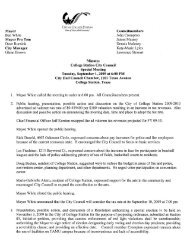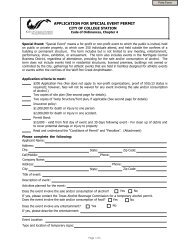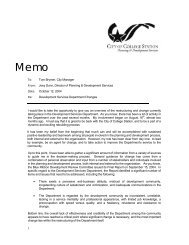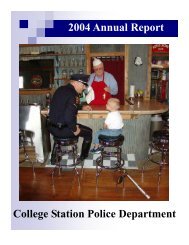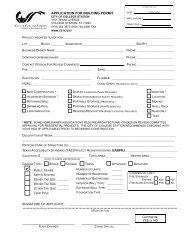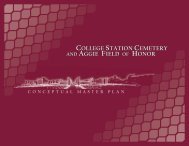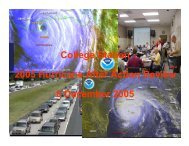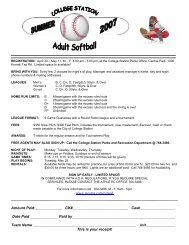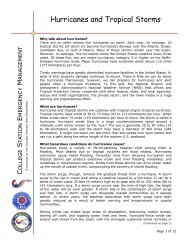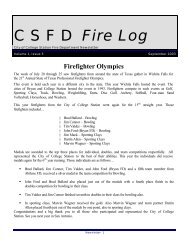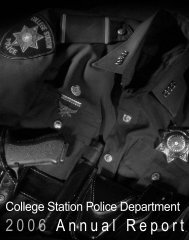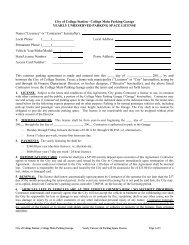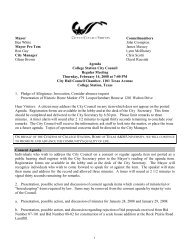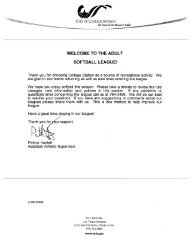standard operating procedure college station fire department
standard operating procedure college station fire department
standard operating procedure college station fire department
Create successful ePaper yourself
Turn your PDF publications into a flip-book with our unique Google optimized e-Paper software.
STANDARD OPERATING GUIDELINES<br />
COLLEGE STATION FIRE DEPARTMENT<br />
SUBJECT: COMMUNICATIONS FOR AIRPORT RESPONSE SOP: 900.1.20<br />
CATEGORY: ARFF OPERATIONS PAGE: 1 of 3<br />
APPROVED BY:<br />
Chief, Fire Department DATE: 09/01<br />
SCOPE & PURPOSE<br />
This policy is to provide communications guidelines for receiving an alarm, dispatching of unit(s), and<br />
responses to Easterwood Airport for aircraft and airport emergencies by the designated ARFF vehicle<br />
and additional C.S.F.D. units as needed or requested.<br />
RECEIVING AN ALARM for Airport and Aircraft Emergencies<br />
Receipt of an alarm for airport and aircraft emergencies may be reported directly to the ARFF unit<br />
(Rescue 794), Station 4 or C.S.F.D. dispatch. They may be received via:<br />
1) Direct call to dispatch -- Easterwood Tower, Houston Aircraft Control Center or a citizen<br />
911 call, all may report aircraft and airport emergencies directly to dispatch.<br />
2) Direct notification by Easterwood Air Traffic Control Tower (08:00 - 21:00)<br />
The Klaxon, radio, & ring down phone will be used to notify Rescue 794 & <strong>station</strong> 4<br />
3) Direct report to the Fire Station (Walk in)<br />
DISPATCHING OF ALARM<br />
Depending on how the call is received the following shall be performed:<br />
1) Direct call to dispatch<br />
A) Dispatch will obtain as much information about the emergency as possible.<br />
B) Dispatch will respond appropriate units based on the available information.<br />
For Aircraft Emergencies the following will be used to determine level of response:<br />
Alert I (Precautionary Emergency) --- An aircraft that is known or suspected to have an operational<br />
defect that should not normally cause serious difficulty in achieving a safe landing.<br />
Example; unsafe gear lights (gear is down), Aircraft standby<br />
Alert II (Declared Emergency) --- An aircraft that is known or suspected to have an operational<br />
defect that affects normal flight operations to the extent that there is danger of an accident.<br />
Example; smoke in aircraft, landing gear problems<br />
Note!! All air carrier aircraft emergencies will be treated at a minimum as an Alert II<br />
Alert III (Aircraft Accident) --- An aircraft incident /accident has occurred on or in the immediate<br />
vicinity of the airport.<br />
Re#’d 11/02



